Indigo: The Tale of Jeans, Slavery and Mysticism
Dark-blue history

miniature from L'instruction d'un jeune Prince. Georges Chastellain giving book to Charles the Bold. between 1450 and 1475/Wikimedia Commons
The colour blue has had a very complicated history in the culture of humankind due to limited amounts of it in the world that surrounds us. The name of one of the shades of blue, ‘Indigo’ still seems unclear to some even though indigo was one of the first and most important blue dyes.
The indigo shade sits in the spectrum of the blue color family between dark blue and purple. For many people, the word ‘indigo’ sounds exotic and strange, and they struggle to distinguish it from others. There is a direct connection between language and color perception, proven by well-known scientists such as Jules Davidoff and Jonathan Weaver. This is because color is psychophysiological and subjective for each person and their perception of light reflecting off a surface, etc. This is why our perception of light greatly depends on our habits and culture.
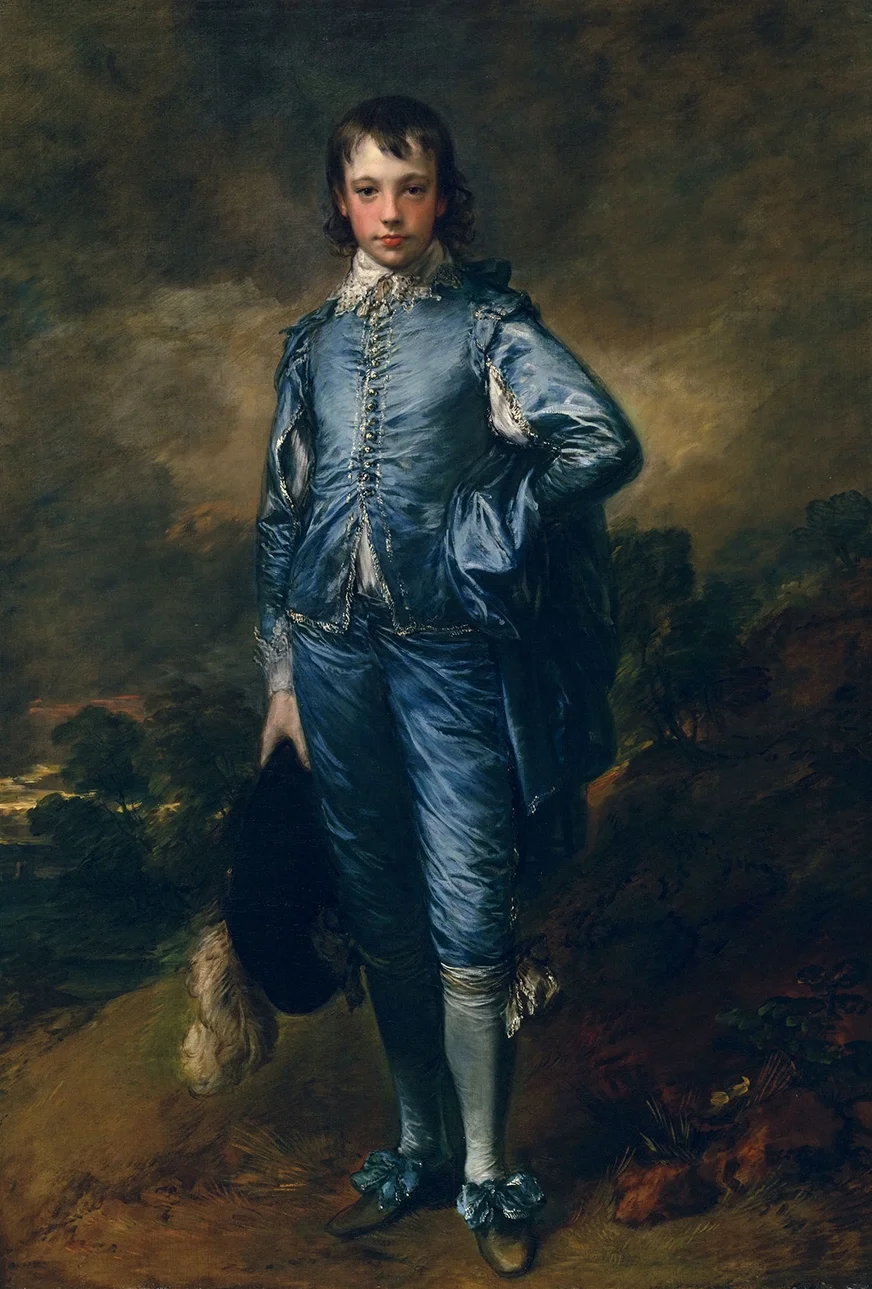
The Blue Boy by Thomas Gainsborough/Wikimedia commons
There is blue but there is no word
The colour blue in all its variations was very unlucky for a very long time. According to philosopher Lazarus Geiger even the ancient Greeks didn’t have a word for “blue” for a long time and a lot later they started using a word that previously meant black or slate grey. Therefore, if Homer compared the sky to bronze and the sea to wine, it doesn’t mean that he saw yellow skies or red sea water, he most likely means the sparkle and the play of colours and not the colour itself, as the Greeks didn’t even have the concept of blue at that time. The term also didn’t exist in classical Latin so Romance languages had to borrow it from their Germanic neighbours. Chinese and Japanese, as many others, did not really see the difference between blue and green for a long time and can call the new leaves blue to this day.

Kök Bazar (Green Bazaar, aka Zelyony Bazar), Zenkov Street / Jibek Joly Street, Almaty, Kazakhstan /Ian Bottle /Alamy
Even if you are not quite sure what indigo looks like just take a look at a classic pair of jeans which you can most likely find in your wardrobe. Do you know why the first jeans were blue and not red or black? Because indigo was one of very few natural pigments that could reliably dye cotton, including denim.

1982 Levi's 501 Jeans Ad - Jeans Made to Fit Women/Alamy
Ancient Egypt synthesis
The ancient Egyptians not only knew the word “blue” but were also first in the world to learn to synthesise this pigment. Its traces were found on an alabaster bowl that is over five thousand years old, and if you think that the history of synthetic dyes only dates back a couple of centuries, bear in mind that it goes back much further than that.
Egyptian blue was made from calcite (CaCO3), quartz sand (SiO2) and copper minerals azurite and malachite or copper shavings. A flux (K2CO3, NaCl или Na2SO4) was added to the mix of the components which lowered the melting temperature, after which the mixture was heated to 800-900°C and Egyptian blue was formed.
This process required maintaining of constant temperature and air purging as lack of oxygen could cause the formation of the red copper oxide cuprite (Cu2O). It is clear that in ancient Egypt this technological process was perfected through generations and was passed down from one generation of craftsmen to another. However modern people only managed to duplicate it towards the end of the 20th century.
Blue war coloured grass
Dyer’s weed (Isatis tinctoria) grows in Armenia, Western and Central Asia, the North Caucasus, Dagestan, Western Siberia, European Russia, and in many countries of Europe and North Africa. It’s a small bush measuring up to 1 meter tall with yellow flowers. Since ancient times, the leaves of this plant have been used to dye wool blue and green, especially to make rugs. ‘Dyer’s weed replaces indigo here,’ wrote Vladimir Dal in the second edition of his Explanatory Dictionary of the Living Great Russian Language.

Isatis tinctoria L. «Bilder ur Nordens Flora» Stockholm Carl Axel Magnus Lindman (1856–1928)/Wikimedia Commons
Incidentally, this plant also grows in Kazakhstan and in Xinjiang, the nearest Chinese province. And so, your great-great-grandma’s dress or your great-great-grandpa’s best chapan could easily have been made from fabric dyed using dyer’s weed.
The seeds of the dyer’s weed plant are easily carried in the wind, making it a highly invasive weed (its name in English speaks for itself). For example, in the American state of Utah, where this plant was planted by Mormons to use it in dyeing fabrics, efforts to control remain rather unsuccessful.
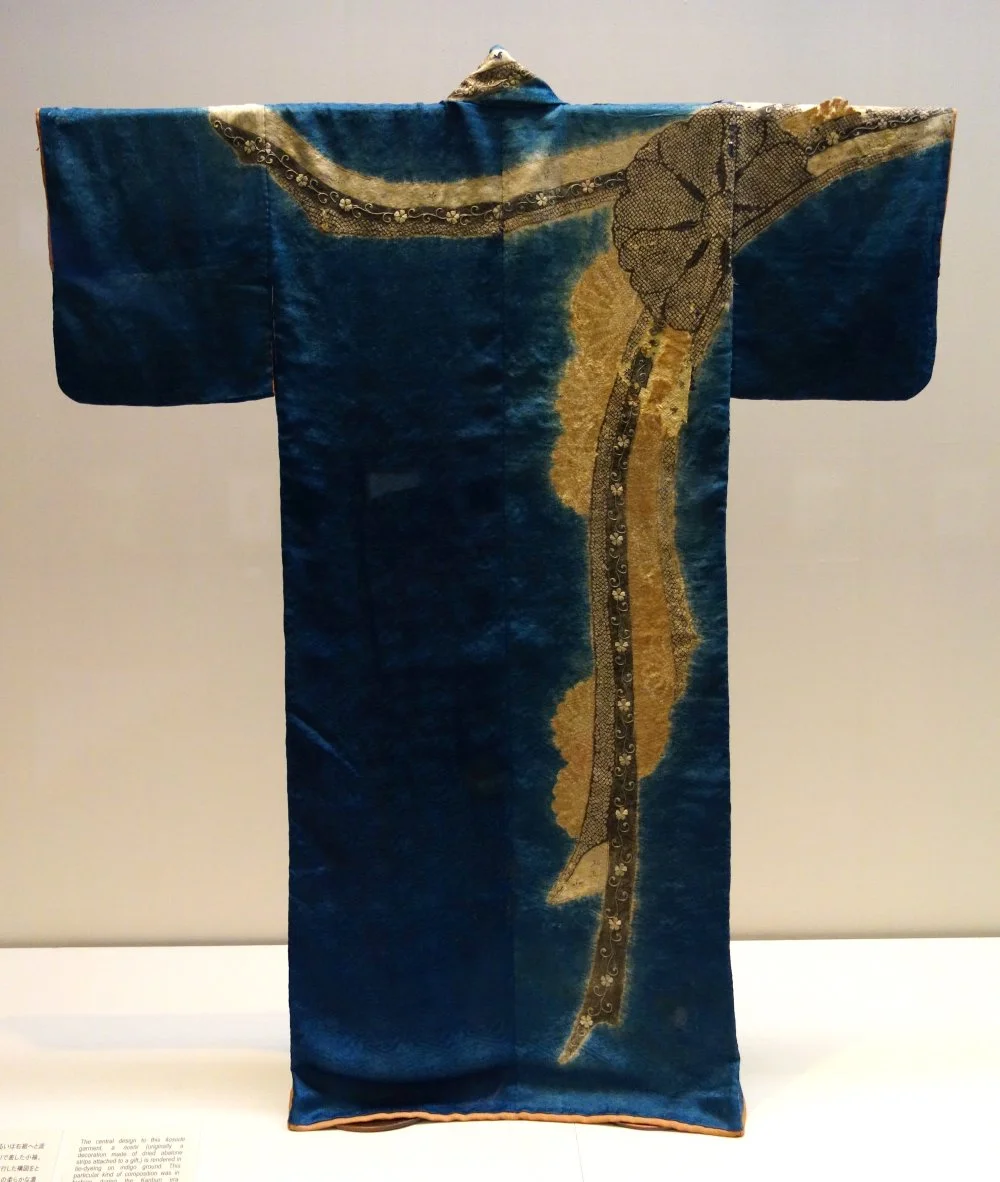
Japanese clothing "kosode". The satin fabric is dyed indigo. 17th century/Wikimedia commons
However, ancient Britons were not at all bothered by the spread of dyer’s weed. They used the pigment not only for dyeing clothes but also for painting their own bodies. English textbooks mention that Boudicca (60–61 BCE), the queen of the Britons, led the troops to battle wearing a blue dress, and the great warrior king Caractacus (25–54 CE) covered himself head to toe in blue dye before each battle.i

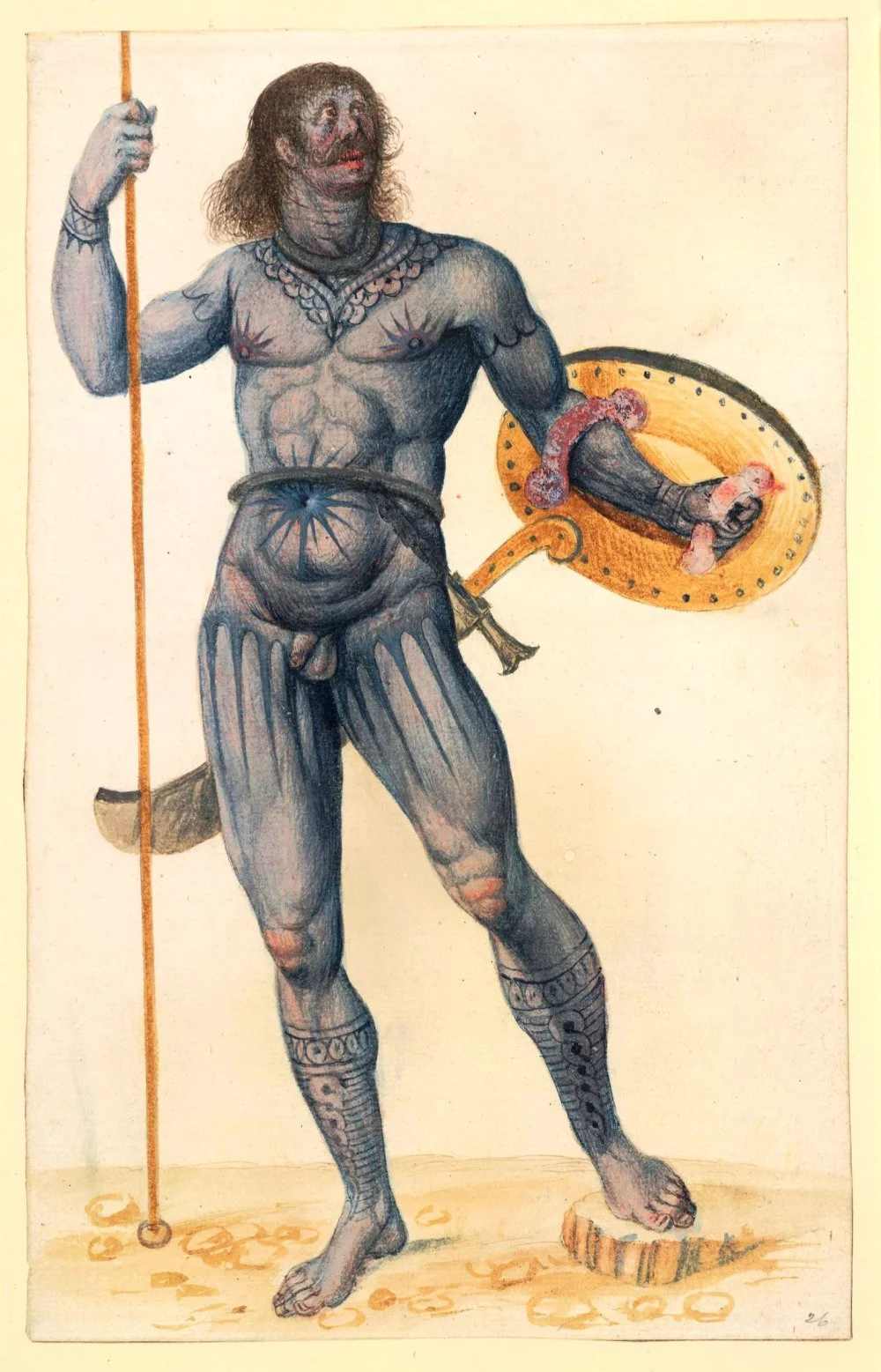
A 'Pict warrior'; nude with stained and painted body /The Trustees of the British Museum
Obtaining the pigment from dyer’s weed is relatively simple. Freshly cut leaves of the plant are placed into a pit for 12–24 hours and are covered in water. When they ferment, carbon dioxide is released and the dye carrier transfers into the liquid and colors it yellow. The resulting solution is then poured into containers where with constant stirring, it comes into contact with the air. This process produces indigo, which appears in the form of sediment consisting of blue flakes. The mass is washed, pressed out, and molded. It is interesting though that dyer’s weed only contains 10–15 per cent of indigotin.
Indigo means ‘Indian’
Indigofera tinctoria, a bush that grows in India and is cultivated in various tropical and subtropical regions, contains much more indigo pigment, up to 90 per cent. ‘They started growing indigo in the Indus Valley and in the local dialect, the plant was called “nila” which means dark blue’. From here, the culture spread in all directions. The British Museum contains a tablet with Babylonian dye recipes dating to the seventh century BC, which means that indigo was known in Mesopotamia more than 2,500 years ago,” writes British journalist, writer and social anthropologist Victoria Finlay in her book Colour: A Natural History of the Palette.

Pergamon Museum, Ishtar gate/Wikimedia commons
India was the main supplier of indigo to Europe even in the times of the Greco-Roman Empire. The connection between India and indigo is reflected in the Greek name for the dye, ‘indikón’ (Ἰνδικόν). The Romans, who used indigo as a pigment to paint with and for medicinal and cosmetic purposes, latinized the term, turning it into ‘indicum’, which then transformed into Venetian dialect and later into many modern languages as ‘indigo’.
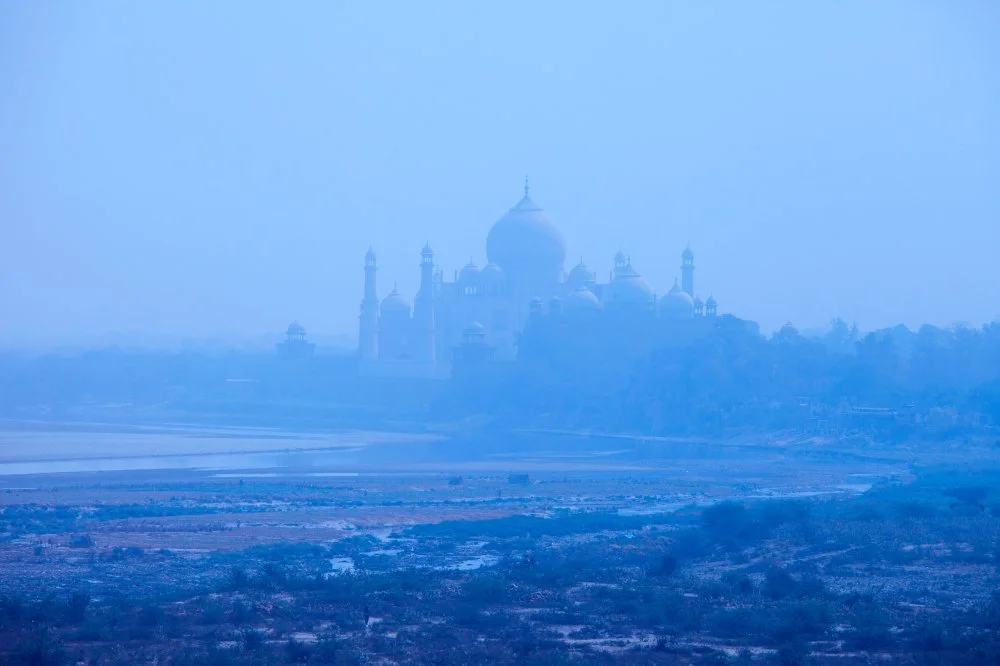
Taj Mahal, Agra, India, Jim Zuckerman/Alamy
Historian Michel Pastoureau states that the Romans and before them the Greeks ‘were not aware of its plant origin. The leaves of the indigo plant were ground and turned into a paste-like mixture which was then dried and then shipped and sold in the shape of small bars. Therefore, the consumers in Europe mistook them for minerals. Following Dioscorides,i
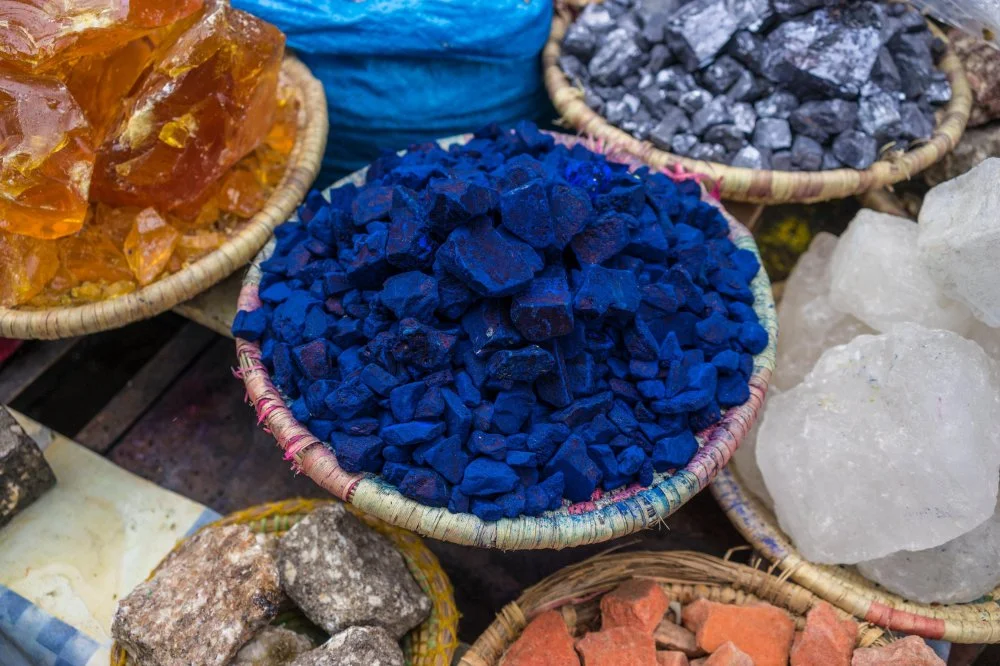
Indigo, color pigment, at the bazaar, Marrakech, Morocco/Alamy
Dyer’s weed vs Indigo – a lost war
In the Middle Ages indigo was brought to Europe from India by Arabic merchants and this dye remained an item of luxury up until the end of the 15th century when a Portuguese voyager, Vasco Da Gama, discovered a marine passage to India. Sea transportation took less time and was safer than travelling by land, and apart from that there was no need to pay heavy duties at the borders of various countries which trading caravans had to cross. Europe had such an influx of tropical indigo pushing out a lower quality dyer’s weed, that France and Germany in the 16th century were forced to ban its import in order to protect local industry. In England indigo was officially banned as those who protected the interests of dyer’s weed sellers managed to have the harmless indigo declared poisonous. However from the 1630s this ban that officially was present up until 1660, was openly ignored, because the members of the East India Companyi
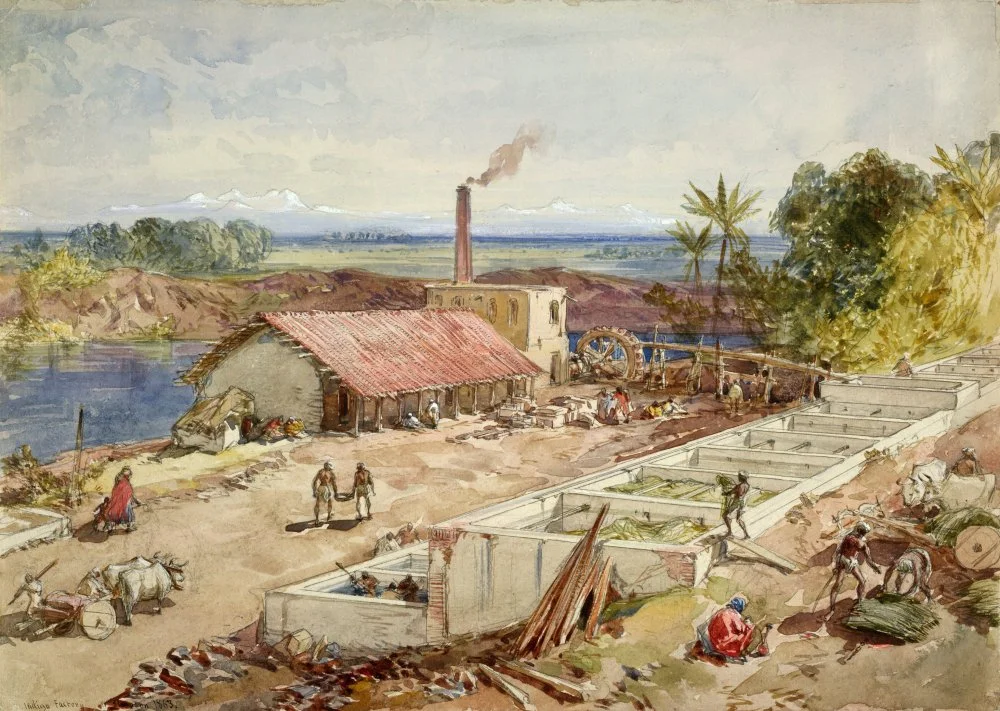
Scottish artist William Simpson (1823-1899). Indigo dye factory in Bengal(now West Bengal and Bangladesh). 1863/Alamy
Slaves of deepest blue
When it became clear that dyer’s weed could not compete with indigo, many European states, Spain for example, began establishing indigofera plantations in their tropical colonies. ‘The French started cultivating this plant on the islands of Dominica, Martinique, and Guadalupe. The climate could not be better, and besides the process of growing indigo involves hard physical labor, and the French had slaves at their disposal. This was not only done by the Europeans. Yoruba slaves were doing the same in their homeland, in West Africa, for almost 1,000 years after the Arabs introduced them to indigo, and slave labor was also used in Africa. Nigeria is still famous for its blue textiles.’ writes Victoria Finlay.
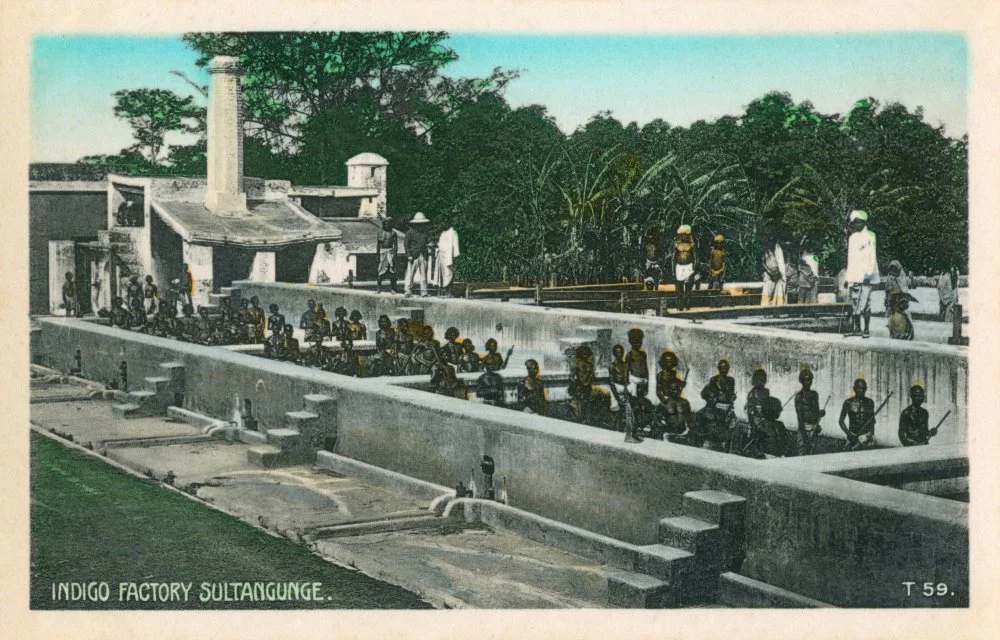
Indigo Factory at Sultanganj, Bihar, India/Alamy
The production of indigo in the region of modern-day Salvador was carried out under such unhealthy conditions that the indigenous people who were forced to work there practically died out after a few generations of exploitation. The precious dye was also produced in Haiti, Jamaica, the Virgin Islands, and Central and South America. In the middle of the eighteenth century, the production of indigo was started by Elisa Lucas Pinkney, the daughter and wife of a plantation owner, in the American state of South Carolina. She used seeds from Antigua and generously gave seedlings to neighboring plantation owners. Of course, they also had slaves working on their plantations to tend to the crop. By 1750, England bought 30,000 tons of indigo from Carolina, and in 1755, this figure reached 500,000 tons.

Dress of the reign of William III, early in the reign of Queen Anne 1689~1707. Handcoloured lithograph from "Costumes of British Ladies from the Time of William the First to the Reign of Queen Victoria,” London. 1840/Alamy
Mystical Indigo
Elisa Lucas was unaware that there was a plant much more resistant to the local climate in Central and South America. This plant was Indigofera suffruticosa, and the dye derived from this had been used by the people of Mesoamerica since the most ancient times. The Maya made turquoise for their wall paintings by mixing indigo and local clay. The result was a very beautiful shade of light blue, and up until the 1960s, it was thought that Maya made the dye from metal. The Aztecs used indigo in medicine and applied blue paint to sacrificial animals.
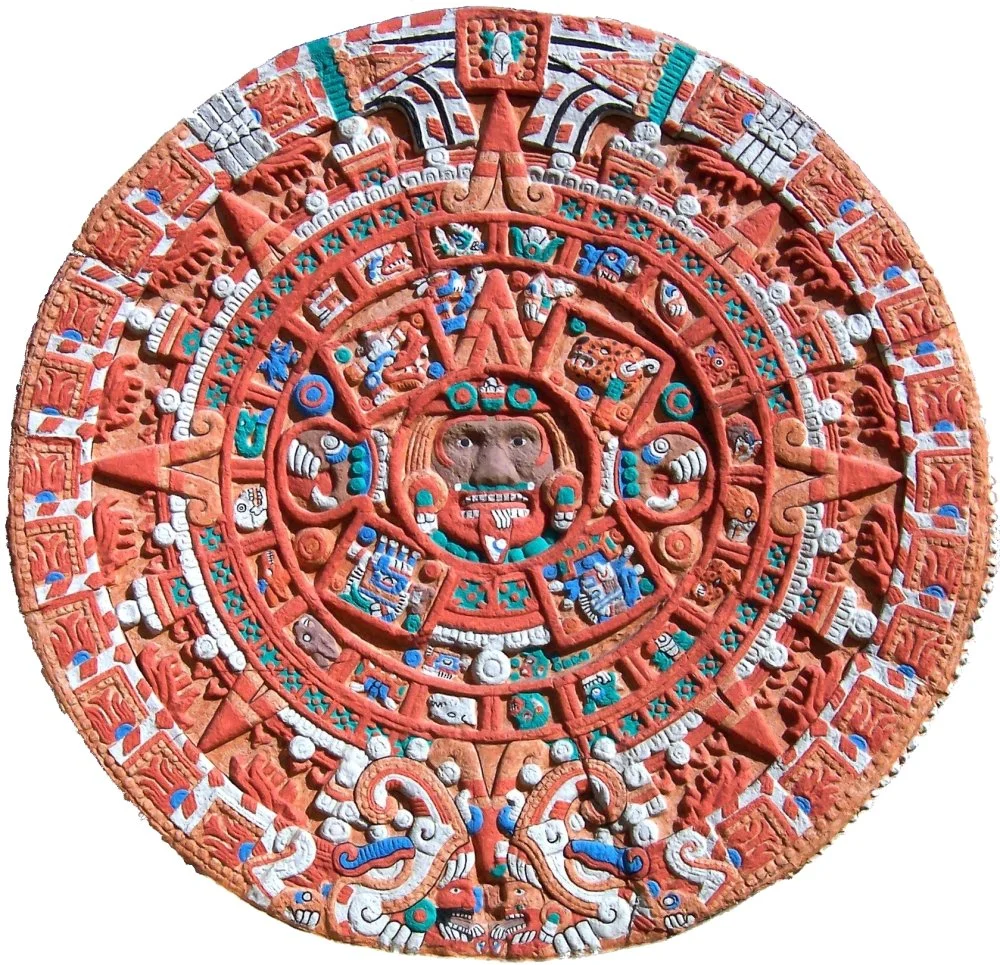
Aztec Sun Stone Replica/Wikimedia Commons
Victoria Finlay writes that in many cultures indigo was considered a mystical color that had feelings and changed according to them: “For example, on the island of Java, it is believed that indigo doesn’t like it when spouses argue. In Bhutan, a pregnant woman is not allowed anywhere near the dye container so that her unborn baby does not steal the blue. Women in the mountains of Morocco try to placate spoiled paint by telling it stories.’
Indigo for all
In the nineteenth century, while trying to overcome their dependency on Great Britain which was exporting natural Indian indigo with a monopoly, many manufacturers approached chemists with requests to synthesize this dye. It is worth remembering that by this time, the ancient secret of deriving indigo was long gone and forgotten. However, the hundreds of methods suggested by scientists turned out to be expensive and proven impractical for industrial-scale use. It was only by the end of the century that Karl Heumann, a German chemist, managed to synthesize indigo using anilin, which was already widely used to synthesize other industrial dyes, and chloroacetic acid that could be easily derived from acetic acid, a derivative from acetic aldehyde. The industry quickly got in on this process, and indigo along with other dyes became available to everyone. Thus, by the beginning of World War I, synthetic indigo had pretty much completely pushed natural indigo out of the market.

Touaregs at the Festival au Desert near Timbuktu, Mali 2012/Alfred Weidinger/Wikimedia commons
REFERENCES
Мишель Пастуро. Синий. История цвета.— М., 2017.
Виктория Финли. Тайная история красок. — М. 2010.
Бальфур-Пол Дженни. Индиго: от египетских мумий до синих джинсов. — Лондон: Издательство Британского музея, 2016.
Записки Юлия Цезаря и его продолжателей о Галльской войне, о Гражданской войне, об Александрийской войне, об Африканской войне.— М., Научно-издательский центр «Ладомир» – «Наука», 1993. Репринтное воспроизведение текста издания 1948 года.



